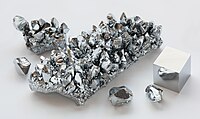
Photo from wikipedia
Abstract To reduce pollution and maintain sustainable development, environmental friendly waterborne coatings as a replacement for conventional oil-based coatings have drawn lots of attention and been widely studied recently. It… Click to show full abstract
Abstract To reduce pollution and maintain sustainable development, environmental friendly waterborne coatings as a replacement for conventional oil-based coatings have drawn lots of attention and been widely studied recently. It is a challenge to overcome the inherited weakness of waterborne coatings including poor scratch-resistance, low hardness and short lifespan. Herein, we have developed a scratch-resistant and self-healing waterborne coating of poly(urethane-urea), which contains a dual metal coordination structure of Zn(II)-carboxyl and Zn(II)-diamidepyridine by using the method of ions penetration. The addition of zinc ions has given dense metal coordination bonds on the coating surface, which has greatly increased the surface hardness (from B to 4H) and scratch-resistance, while the inner layer keeps excellent adhesion (>1.5 MPa) to substrates because of less metal ion penetration to the inner. What's more, the coating exhibits outstanding self-repairing performance, and the repair ability is better under hygrothermal condition. Atomic force microscope (AFM), dynamic mechanical analysis (DMA) and thermal analysis were used to characterize the self-healing and hardening mechanisms of the coatings. These results are expected to provide a useful method to improve the overall strength of waterborne coating.
Journal Title: Chemical Engineering Journal
Year Published: 2021
Link to full text (if available)
Share on Social Media: Sign Up to like & get
recommendations!